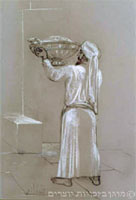
Rooted in the time when the Holy Temple was in its glory, the Omer celebration symbolizes our anticipation and desire for God’s teachings and the Torah. The 49-day counting guides believers through some of the most meaningful events in Jewish history, commemorating some of our greatest scholars too.
Root of the Tradition of the Omer
The term “Omer” goes back to the flourishing period of Beit Hamikdash (Holy Temple). It refers to a measure of newly harvested barley that was ceremonially offered on the second day of Passover (Pesach). This offering, made by the Sanhedrin and farmers together, was a thanksgiving gift to God for the harvest.


The Ritual of Counting the Days
From the sixteenth of Nisan until the beginning of Shavuot, the Festival of the Giving of the Torah, Jews observe a unique tradition. They are commanded to count forty-nine nights, or seven weeks. This practice, detailed in the Torah (Leviticus 23:15-16), is called “Sefirat HaOmer”.
At the conclusion of the Omer counting, just before the wheat harvest, two measures of wheat flour were once again offered to God, marking the end of the Omer period and the beginning of Shavuot. This practice is known as “Sefirat HaOmer” ((ספירת העומר, which recalls the journey of the Israelites from Egypt to Mount Sinai and their receiving of the Torah after forty-nine days. In other words, Sefirat HaOmer symbolizes the Jewish anticipation for the Torah and God’s teachings.
The Berakhah of the Omer
The prayer for counting the Omer is as follows:
בָּרוּךְ אַתָּה ה’ אֱלהֵינוּ מֶלֶךְ הָעולָם, אֲשֶׁר קִדְּשָׁנוּ בְּמִצְותָיו וְצִוָּנוּ עַל סְפִירַת הָעומֶר.
Translation: “Blessed are You, Lord our God, King of the universe, who has sanctified us with His commandments and commanded us concerning the counting of the Omer.”
For example, on the first day of the Omer, one would say: “Today is the first day of the Omer.”
Lag BaOmer
The pilgrimage to Galilee
The thirty-third day of the Omer, coinciding with the eighteenth of Iyar, marks the anniversary of the passing of the revered sage and the greatest Kabbalist Rabbi Shimon bar Yochai. Every year, especially since the sixteenth century, it has been customary to gather at his tomb in Meron (Galilee) and celebrate a grand festival known as “Hillula”.
Thousands of pilgrims from near and far gather annually at Meron, carrying Torah scrolls adorned with colorful flags. They march joyously towards the tomb of Rabbi Shimon and his son Elazar, dancing and singing religious hymns. Upon reaching Meron, the celebration continues with further dancing and festivities. In the evening, upon reaching the city of Meron, they gather in the courtyard of the tomb to dance and celebrate once more.
The Significance of Hillula
Lag BaOmer has famously become known as the festival of Rabbi Shimon or Hillula. In Hebrew, Hillula means the day of a bridegroom entering his wedding canopy. Rabbi Shimon perceived death as a great birth, a reunion with the Divine. Thus, his death anniversary is celebrated as Hillula.
Rabbi Shimon bar Yochai
Fleeing from Hadrian
Rabbi Shimon bar Yochai, a disciple of Rabbi Akiva, resisted the Roman oppression of his time with all his strength. Eventually, Emperor Hadrian issued a decree for his death, forcing him to flee. He and his son Elazar took refuge in a cave in northern Israel, living in seclusion for thirteen years, sustained only by a carob tree and a spring. During this time, Rabbi Shimon reached the peak of spiritual enlightenment and mysticism. His students often visited in secret to seek his wisdom and teachings.
Far removed from all the pleasures of life, he managed to survive this period having reached the pinnacle of mysticism and spiritual perfection. Friends and fellow seekers would occasionally visit Rabbi Shimon in the cave, sometimes for political teachings and sometimes for spiritual guidance. They came in secret, held mystical and religious gatherings, discussed various scriptures and other matters, benefiting from his profound wisdom.
Contributions after exile
After the emperor’s death and the repeal of oppressive decrees, Rabbi Shimon and his son emerged from hiding. Despite his physical frailty, Rabbi Shimon’s spiritual strength allowed him to significantly contribute to Jewish culture and herald a new era for the Jewish faith, notably in authoring the “Zohar”, which reveals profound Torah secrets.
Additional Notes on Omer
- Counting the Omer begins on the second night of Pesach and continues for forty-nine nights until Shavuot.
- The berakhah can be recited from nightfall until dawn of the following day.
- Women are exempt from this mitzvah (commandment).
- If one misses counting on one of the nights, he may count the missed night on the following day, however, without a berakhah.
- It’s best to recite לשם יחוד, since the original Omer mitzvah is no longer practiced.
- According to tradition, twenty-four thousand students and followers of Rabbi Akiva lost their lives in a tragic incident in the second century AD, between Passover and 18th of Iyar, which is the 33rd day of the Omer. In their honor, Jews observe a period of mourning until the thirty-third day of the Omer, called Lag BaOmer. During these days, they refrain from holding celebrations and joyous events. Many also avoid buying new clothes, cutting their hair, and listening to music as a mark of respect and remembrance


 فارسی
فارسی